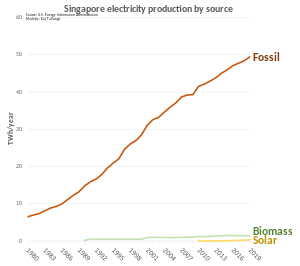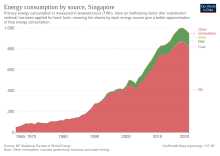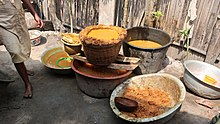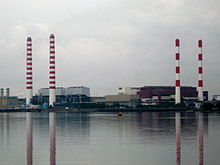Energy in Singapore
Total energy supply 2021[1]
Energy in Singapore is critically influenced by its strategic position in maritime Southeast Asia, nestled between Malaysia and the Singapore Strait, near essential maritime routes like the Straits of Malacca and the South China Sea. This location has established Singapore as a central hub for the global petroleum, petrochemical, and chemical industries, with Jurong Island serving as a key base for over 100 international companies in these sectors. The majority of Singapore's energy consumption is derived from petroleum and other liquids, accounting for 86% of its total energy use, while natural gas represents 13%, and coal and renewable resources make up the remaining 1%.[2]
Energy in Singapore has evolved in response to its environmental impact and reliance on fossil fuels. The government has implemented several strategies to transition towards a more sustainable energy model. In 2019, Singapore introduced the Carbon Pricing Act, aimed at reducing carbon emissions by imposing a tax on greenhouse gas emissions. Concurrently, the Energy Market Authority launched the "4 Switches" strategy, which focuses on enhancing energy efficiency, increasing the adoption of renewable energy sources, and integrating advanced technologies such as carbon capture and storage.[2]

In addition to legislative measures, the Singapore Green Plan has been developed to set forth clear objectives for environmental improvement and sustainability. This plan includes initiatives to expand green spaces, phase out new registrations of diesel vehicles by 2025, significantly expand the electric vehicle charging infrastructure, and increase the deployment of solar energy to 2 gigawatts by 2030.[2]
Furthermore, in terms of energy policy, Singapore has set ambitious targets aimed at enhancing energy efficiency and reducing its environmental impact. By 2030, the country plans to improve its energy efficiency by 36% compared to levels in 2005. Supporting measures have included implementing energy efficiency standards and introducing labeling for lamps in 2015. Additionally, Singapore is working to increase its solar photovoltaic (PV) capacity and aims to reduce greenhouse gas emissions by 16% below what they would be in 2020, with emissions expected to peak by 2030.[2][3]
Overview
| Population (million) |
Prim. energy (TWh) |
Production (TWh) |
Import (TWh) |
Electricity (TWh) |
CO2-emission (Mt) | |
|---|---|---|---|---|---|---|
| 2004 | 4.24 | 298 | 0 | 548 | 34.6 | 38.1 |
| 2007 | 4.59 | 311 | 0 | 628 | 39.1 | 45.0 |
| 2008 | 4.84 | 215 | 0 | 650 | 39.6 | 44.3 |
| 2009 | 5.0 | 215 | 0 | 685 | 39.7 | 44.8 |
| 2012 | 5.2 | 388 | 11 | 919 | 43.6 | 64.8 |
| 2012R | 5.31 | 291 | 7.0 | 823 | 46.2 | 49.8 |
| 2013 | 5.40 | 304 | 7.4 | 855 | 47.7 | 46.6 |
| Change 2004–09 | 17.7% | -27.8% | 0% | 25.1% | 14.5% | 17.8% |
| Mtoe = 11.63 TWh, Prim. energy includes energy losses
2012R = CO2 calculation criteria changed, numbers updated | ||||||

According to the IEA Singapore had no energy production in 2008. Energy imports increased 18.6% in 2008 compared to 2004. The primary energy declined by about one third in 2007-8 but during the same period energy imports increased. Energy import was about three times the total primary energy supply in 2008. Compared to the UK in 2008, per capita electricity consumption was 135% and per capita carbon dioxide emissions were 110%. (UK: 61.35 m people 372.19 TWh electricity, 510.63Mt CO2 emissions).[5] The use of energy (primary energy) in Singapore is only 1/3 of the imported energy.
Singapore's Energy Story
In 2019, then Minister for Trade and Industry Chan Chun Sing spoke about the Singapore Energy Story to guide the energy sector towards greater sustainability, while maintaining a reliable and affordable energy supply.[6]
As part of its energy transition towards cleaner energy, Singapore will make use of four supply switches, supported with efforts in energy efficiency to reduce energy demand.[7]
Oil
In 2021, Singapore's oil supply totaled 1,027,948 terajoules, a 42% increase from 2000, comprising both crude and refined products, net of exports and storage. Oil constituted 69.7% of the total energy supply.[8]
All of Singapore's crude oil was imported, with imports growing by 13% since 2000. Oil products imports surged to 208.8% of total consumption, a significant rise of 159% over the same period. Crude oil and oil products represented 30% and 63% of total energy imports, respectively.[8]
Oil products were mainly used in transport and non-energy sectors like plastics and chemicals production. Non-energy use comprised 55% of oil products' final consumption, with naphtha being the most consumed, accounting for 50%. These figures highlight Singapore’s heavy reliance on imported oil and the associated environmental challenges.[8]
Natural Gas
Around 95 per cent of Singapore's electricity is produced using piped or liquefied natural gas (LNG). Natural gas will remain a key fuel for Singapore's power generation as it scales up efforts to harness solar and develop other low-carbon technologies.[9]
In the early 2000s, Singapore started receiving natural gas from Malaysia and Indonesia via pipelines.[10] To further diversify its gas sources, the city-state began importing LNG via the Singapore SLNG Terminal which began operations in May 2013.[11][12]
In 2008, BG Group (which merged with Shell in 2016) won an exclusive franchise to supply as much as 3 million tonnes per annum (mpta) of LNG.[13] Energy Market Authority (EMA) subsequently launched a competitive Request for Proposal process in 2014 which saw Shell Eastern and Pavilion Gas being appointed LNG importers in 2016.[14] Another two term importers - ExxonMobil LNG Asia Pacific and Sembcorp Fuels - were subsequently appointed in 2021.[15]
In 2021, Singapore's natural gas imports showed a staggering increase, climbing by 754% since 2000, with the entire supply sourced from international markets. This total reliance on external sources poses significant energy security concerns, heightened by global events such as Russia’s invasion of Ukraine. The natural gas sector is pivotal in both the energy and industrial sectors in Singapore. It fueled 93.9% of the total electricity generation in 2021—an 804% rise since 2000. Additionally, the industrial sector, which mainly uses natural gas for chemicals and plastics production, accounted for 89% of its final consumption. CO2 emissions from natural gas were 22.528 million tonnes in 2021, up by 684% from 2000, highlighting the need for stringent environmental management despite its status as a cleaner alternative to coal and oil.[8]
In 2022, Singapore launched a Request for Proposal to appoint up to two LNG importers to provide more options for gas buyers, in addition to the four term importers.[16]
Solar
Solar is considered to be Singapore's most viable renewable energy option, as the island nation is "alternative-energy disadvantaged" with low wind speeds, low tidal range, and no hydro resources.[17]
| 2014 | 2015 | 2016 | 2017 | 2018 | 2019 | 2020 | 2021 | 2022 | 2023 |
| 26 | 46 | 97 | 116 | 162 | 272 | 332 | 487 | 633 | 774 |
In 2020, Singapore achieved its target of deploying 350 megawatt-peak (MWp) of solar.[19] Under the Singapore Green Plan, the country aims to achieve 2 gigawatt-peak of solar by 2030, equivalent to powering around 350,000 households a year.[20]
Singapore also aims to deploy 200 megawatts (MW) of energy storage systems beyond 2025 to mitigate solar intermittency and reduce peak demand. The first utility-scale energy storage system testbed was deployed at a substation in Woodlands in October 2020.[21] EMA has also partnered with Keppel Offshore & Marine to pilot Singapore's first floating energy storage system.[22]
Regional Power Grids
Singapore plans to tap on regional power grids to access low-carbon electricity beyond its borders. It plans to import up to 6 gigawatts (GW) of low-carbon electricity by 2035, which could make up around 30 per cent of the country's energy needs in 2035.[23]
EMA had been carrying out trials to import electricity from regional power grids, such as a two-year trial to import 100 megawatts (MW) of electricity from Peninsular Malaysia, 100MW of electricity from Laos via the Lao DPR-Thailand-Malaysia-Singapore Power Integration Project (LTMS-PIP) under the ASEAN Power Grid Project, and 100MW equivalent of non-intermittent electricity from a solar farm in Pulau Bulan, Indonesia.[24]
The wider ASEAN Power Grid project is attempting to create a number of cross border connections from Singapore to other ASEAN nations.[25]
In November 2021, EMA issued its first request for proposals to appoint electricity importers to import and sell about 1.2 GW of low-carbon electricity into Singapore, to begin by 2027.[26] In July 2022, EMA issued its second request for proposals for low-carbon electricity imports, and streamlined the process to evaluate proposals from both proposal request exercises.[27]
Low-Carbon Alternatives
Singapore is also studying different low-carbon technologies such as hydrogen, carbon capture, utilisation and storage and geothermal energy for possible adoption in the longer term.
In October 2020, the Singapore Government announced a $49 million low-carbon energy research funding initiative to support research, development and demonstration projects in low-carbon technologies, such as hydrogen and carbon capture, utilisation and storage.[28] This was later expanded to $55 million in 2021, with the funds going to 12 research projects.[29]
In April 2022, EMA issued a Request for Information in its bid to assess the potential of geothermal energy across Singapore. EMA planned to follow up with a Request for Proposal to assess the viability and scalability of deploying geothermal systems in Singapore.[30]
Energy Efficiency
In 2018, EMA launched the Genco Energy Efficiency Grant Call to encourage power generation companies to adopt energy efficiency technologies by co-funding up to 50 per cent of their projects.[31] This was part of the Enhanced Industry Energy Efficiency Package that was announced by the Singapore Government that same year. In October 2020, $23 million in grants were awarded to three power generation companies for energy efficiency projects.[32]
The industrial sector can also tap on the Resource Energy Efficient Grant,[33] supported by the Economic Development Board, and the Energy Efficiency Fund,[34] supported by the National Environment Agency.
| 2011 | 2012 | 2013 | 2014 | 2015 | 2016 | 2017 | 2018 | 2019 | 2020 | 2021 |
| 1208 | 1202 | 1217 | 1259 | 1329 | 1372 | 1405 | 1432 | 1403 | 1343 | 1330 |
By end 2024, all households in Singapore will have advanced electricity meters installed in their premises that will enable them to track and manage their electricity consumption.[36]
Singapore was the top 10th country in oil imports in 2008: 50 megatonnes. For comparison, oil imports in Spain were 77 megatonnes (the top 8th country, with a population of 45.59 million) and in Italy they were 73 megatonnes (the top 9th country, with a population of 59.89 million).[37]
Palm oil
The biggest palm oil-based diesel plant in the world, 800,000 t/a production, started operations in Singapore at the end of 2010 by Neste Oil from Finland.[38] The plant requires almost a million tonnes of raw material annually from the oil palm Elaeis guineensis, equivalent to 2,600–3,400 km2 oil palm plantation.
Greenpeace demonstrated in November 2010 in Espoo, Finland, by hanging an orangutan puppet in front of Neste Oil, saying that Neste Oil endangers the rainforest ecosystem. According to UNEP the majority of new palm oil plantations take place in the rainforests.[39]

According to European Union studies the increased demand for palm oil inevitably leads to new plantations being established in the forests and peat land areas. Land use changes have large green house gas emissions making palm oil diesel much more harmful than petroleum in respect to global warming. According to Greenpeace the Neste Oil plant in Singapore made Finnish Neste Oil among the world's leading palm oil consumers leading to increased rain forest destruction.[40]
Reducing emissions from deforestation and forest degradation (REDD) would be a way to mitigate climate change. According to UNEP the international REDD mechanism will be a key element of Post–Kyoto Protocol negotiations on the post-2012 international climate change regime.[41]
Electricity

The electricity sector in Singapore ranges from generation, transmission, distribution and retailing of electricity in Singapore.
Electricity sector in Singapore is regulated by the Energy Market Authority (Chinese: 新加坡能源管理局).
As of 2015, Singapore uses natural gas (95%) and waste (4%) for power stations' fuel. Oil used to contribute 23% in 2005 but now is down to 1%.[42] The fossil fuel basis of Singapore's electricity system affects the way that electric cars are taxed.[43][44]
| 2011 | 2012 | 2013 | 2014 | 2015 | 2016 | 2017 | 2018 | 2019 | 2020 | 2021 |
| 46.0 | 46.9 | 48.0 | 49.3 | 50.3 | 51.6 | 52.2 | 52.9 | 54.1 | 53.1 | 55.8 |
To address its rising electricity demand, driven by sectors such as advanced manufacturing and transport, Singapore is focusing on enhancing its generation capacity. In 2024, the EMA initiated a request for proposals to build and operate two new hydrogen-ready gas-fired power plants, each with a minimum capacity of 600 megawatts. Scheduled to start operations in 2029 and 2030, respectively, these facilities are integral to Singapore's comprehensive strategy to meet an anticipated peak power demand of 11.8 gigawatts by 2030. This effort underscores the nation's commitment to maintaining a reliable and adequate electricity supply for its expanding economy and population.[45]
Companies
- ES Power Singapore
- PacificLight Power Pte Ltd
- Keppel Merlimau Cogen Pte Ltd
- Keppel Seghers
- National Environment Agency
- PowerSeraya Ltd
- SembCorp Cogen Pte Ltd
- Senoko Energy Pte Ltd
- Tuas Power Ltd
Solar power

Jurong Port built a 10MW solar installation on the roofs of its warehouses, expected online by the end of 2015.[46] Singapore set a target of generating solar power to cover 350,000 households in 2030 that would correspond to 4% of the country's electricity demand in 2020.[47] To promote renewable energy in the country it is advised that the government develops incentive and regulatory support mechanism; consolidate solar energy governance; mobilise equity investors and lenders; and specialise in the long-distance trade of renewable energy, especially in the form of hydrogen.[47]
In July 2021 Sembcorp opened one of the world's largest floating solar plants, with 60 MW of panels on the Tengeh Reservoir.[48] Singapore is also planning a 141 MW project on Kranji Reservoir.[49]
Given Singapore's leading position as a financial hub in the ASEAN region, it could maximise its role to promote clean energy investment throughout the entire region.[50] The Australia–ASEAN Power Link is being considered to import 2.2 GW of solar from Northern Territory.
Companies
Wilmar International
Wilmar International is listed in Singapore. Headed by Kuok Khoon Hong, it is the world's largest palm oil firm. Kuok was the third richest person in Singapore in 2009 with a net worth of $3.5 billion.[51] According to Finnwatch in 2007 the Kuok family owned by Malaysian companies a biofuel plant in Indonesia (225 000 t/a).[52] The Wilmar director Martua Sitorus ($3 billion net worth in 2009, 2nd richest in Indonesia) lived in Indonesia in 2009.[53]
In July 2007 Friends of the Earth Netherlands and two Indonesian NGOs accused Wilmar of illegal forest clearances in West Kalimantan, inadequate Environmental Impact Assessments and clearing land outside its concessions. Wilmar denies the allegation. The report calls on Unilever, a major purchaser from Wilmar, to review its purchasing relationship with the company.[54]
Policy instruments to curb carbon dioxide emissions
Carbon tax
On 20 February 2017, Singapore proposed a carbon tax.[55] The proposal was refined to tax large emitters at S$5 (US$3.73) per tonne of greenhouse gas emissions.[56] The Carbon Pricing Act was passed on 20 March 2018[57] and came into force on 1 January 2019.[58]
Singapore's 2022 budget proposes raising the carbon tax to S$25 (US$18.66) in 2024, S$45 (US$33.58) in 2026, and S$50 (US$37.31)–S$80 (US$59.7) by 2030.[59]
References
- ^ "Singapore - Countries & Regions". IEA. Retrieved 6 June 2024.
- ^ a b c d "International - U.S. Energy Information Administration (EIA)". www.eia.gov. Retrieved 5 June 2024.
- ^ "Singapore - Countries & Regions". IEA. Retrieved 6 June 2024.
- ^ IEA Key World Energy Statistics Statistics 2015 Archived 4 March 2016 at the Wayback Machine, 2014 (2012R as in November 2015 Archived 5 April 2015 at the Wayback Machine + 2012 as in March 2014 is comparable to previous years statistical calculation criteria, 2013 Archived 2 September 2014 at the Wayback Machine, 2012 Archived 9 March 2013 at the Wayback Machine, 2011 Archived 27 October 2011 at the Wayback Machine, 2010 Archived 11 October 2010 at the Wayback Machine, 2009 Archived 7 October 2013 at the Wayback Machine, 2006 Archived 12 October 2009 at the Wayback Machine IEA October, crude oil p.11, coal p. 13 gas p. 15
- ^ IEA Key energy statistics 2010 Archived 11 October 2010 at the Wayback Machine Page: 23, 52, 54 56
- ^ Tan, Audrey (29 October 2019). "Singapore to ramp up solar energy production to power 350,000 homes by 2030 | The Straits Times". The Straits Times. Retrieved 22 July 2022.
- ^ "Transition to cleaner energy will involve 'trade-offs', EMA to reduce cost impact where feasible: Chief executive". CNA. Retrieved 22 July 2022.
- ^ a b c d "Singapore - Countries & Regions". IEA. Retrieved 6 June 2024.
- ^ Tan, Audrey (29 October 2019). "Singapore will continue to rely on natural gas amidst push to boost solar capacity: Chan Chun Sing | The Straits Times". The Straits Times. Retrieved 22 July 2022.
- ^ Koh, Buck Song (2011). Brighter: Electricity in Singapore, from beginning to beyond. Geok Boi Lee, Frank Pinckers. Singapore: Energy Market Authority. pp. 129–132. ISBN 978-981-08-9532-7. OCLC 741536299.
- ^ "EMA | Overview of Gas Market". www.ema.gov.sg. Retrieved 22 July 2022.
- ^ "EMA | Terminal Development". www.ema.gov.sg. Retrieved 22 July 2022.
- ^ Izundu, Uchenna (19 April 2008). "BG, Singapore sign LNG supply deal". www.ogj.com. Retrieved 22 July 2022.
- ^ "Pavilion Gas and Shell Win Deals to Import LNG into The Republic". Pavilion Energy. 26 October 2016.
- ^ Tan, Felicia (25 March 2021). "EMA appoints ExxonMobil LNG and Sembcorp Fuels as term LNG importers for Singapore". The Edge Markets. Retrieved 22 July 2022.
- ^ Tian, Helene (19 May 2022). "EMA to seek more term LNG importers for Singapore". www.businesstimes.com.sg. Retrieved 22 July 2022.
- ^ "Here comes the sun: Inside Singapore's sustainable energy switch". GovInsider. 30 August 2021. Retrieved 22 July 2022.
- ^ IRENA, International Renewable Energy Agency (2024). "RENEWABLE CAPACITY STATISTICS 2024" (PDF). www.irena.org. Retrieved 5 June 2024.
- ^ Chia, Rachel (23 April 2020). "Singapore hits its 2020 solar deployment target". www.businesstimes.com.sg. Retrieved 22 July 2022.
- ^ Wang, Pauline (29 October 2019). "Government ramps up solar power targets". The Edge Singapore. Retrieved 22 July 2022.
- ^ "Singapore deploys energy storage systems to help maintain reliable source of solar power supply". CNA. Retrieved 22 July 2022.
- ^ "Singapore's First Floating Energy Storage System". www.keppelom.com. 26 October 2020. Retrieved 22 July 2022.
- ^ Begum, Shahana; Baharudin, Hariz (25 October 2024). "Singapore accelerates drive to import low-carbon electricity, raising target from 4GW to 6GW by 2035 | The Straits Times". Retrieved 21 September 2024.
- ^ Tan, Audrey (25 October 2021). "Singapore plans to import 30% of energy from low-carbon sources by 2035 | The Straits Times". www.straitstimes.com. Retrieved 22 July 2022.
- ^ "Building the ASEAN Power Grid: Opportunities and Challenges". SEADS. Retrieved 30 May 2024.
- ^ "EMA issues first request for proposals to import low-carbon electricity into Singapore". CNA. Retrieved 22 July 2022.
- ^ "EMA issues second request for proposals to import low-carbon electricity into Singapore". CNA. Retrieved 22 July 2022.
- ^ "Singapore Government announces $49 million Low-Carbon Energy Research Funding Initiative". OpenGov Asia. 27 October 2020. Retrieved 22 July 2022.
- ^ Tan, Audrey (25 October 2021). "S'pore pledges $10m in new funds, making more investments in low-carbon technology | The Straits Times". www.straitstimes.com. Retrieved 22 July 2022.
- ^ "EMA issues Request for Information to assess geothermal energy potential across Singapore". CNA. Retrieved 22 July 2022.
- ^ "Enhanced Industry Energy Efficiency Package for the Adoption of Energy Efficiency Technologies". www.nccs.gov.sg. Retrieved 22 July 2022.
- ^ "S$23 million in grants awarded to 3 power generation companies for energy efficiency projects". CNA. Retrieved 22 July 2022.
- ^ "Incentives & Schemes for Businesses". Economic Development Board. Retrieved 22 July 2022.
- ^ "Energy Efficiency Fund". www.nea.gov.sg. Retrieved 22 July 2022.
- ^ a b "bp Statistical Review of World Energy" (PDF). www.bp.com (71st ed.). 2022. Retrieved 5 June 2024.
- ^ "Advanced meters among new initiatives to help households manage electricity usage". CNA. Retrieved 22 July 2022.
- ^ IEA Key energy statistics 2010 Archived 11 October 2010 at the Wayback Machine Page: 23, 52, 54, 56
- ^ Neste Oil rakentaa Singaporeen maailman suurimman biodieseltehtaan yle 30 November 2007 (in Finnish)
- ^ The last stand: State of emergency: Illegal logging, fire and palm oil in Indonesia's national parks of the orangutan Archived 1 June 2011 at the Wayback Machine UNEP 2007
- ^ Neste Oilin Singaporen laitos kiihdyttää sademetsätuhoa, Greenpeace 15 November 2010
- ^ Environmental Governance UNEP pages 53–63 pdf: 6-Environmental_Governance_UNEP_YearBook_09_low[1].pdf
- ^ Singapore opts for cleaner energy sources
- ^ Tesla Model S owner protests Singapore's carbon emissions surcharge
- ^ Tesla boss calls PM Lee over CO2 levy
- ^ Ong, Sing Yee (4 June 2024). "Singapore Seeks Bids for More Gas Power Plants to Meet Demand". www.bloomberg.com. Retrieved 5 June 2024.
- ^ Shipping Port Gets Super-Sized Rooftop Solar System, Forbes, William Pentland, 17 January 2015
- ^ a b Vakulchuk, R., Chan, H.Y., Kresnawan, M.R., Merdekawati, M., Overland, I., Sagbakken, H.F., Suryadi, B., Utama, N.A. and Yurnaidi, Z. 2020. Singapore: How to Attract More Investment in Renewable Energy? ASEAN Centre for Energy (ACE) Policy Brief Series, No 11. https://www.researchgate.net/publication/341794179
- ^ Lin, Chen (14 July 2021). "Singapore unveils one of the world's biggest floating solar panel farms". Reuters. Retrieved 12 October 2021.
- ^ "MSN". www.msn.com. Retrieved 20 June 2024.
- ^ Overland, Indra; Sagbakken, Haakon Fossum; Chan, Hoy-Yen; Merdekawati, Monika; Suryadi, Beni; Utama, Nuki Agya; Vakulchuk, Roman (December 2021). "The ASEAN climate and energy paradox". Energy and Climate Change. 2: 100019. doi:10.1016/j.egycc.2020.100019. hdl:11250/2734506.
- ^ Singapore's 40 Richest No. 3 Kuok Khoon Hong Forbes 2009
- ^ Palmuöljystä biopolttoainetta FinnWatch / Niko Humalisto 2006
- ^ Martua Sitorus on Indonesia's 40 Richest (2009) Forbes 2 December 2009
- ^ Losing land to palm oil in Kalimantan bbc 3 August 2007
- ^ "Budget 2017: Singapore to impose carbon tax on large direct emitters". CNA. 20 February 2017. Archived from the original on 7 June 2019. Retrieved 7 June 2019.
- ^ Tan, Audrey; Toh, Wen Li (19 February 2018). "Carbon tax Bill passed amid competitiveness concerns". The Straits Times. Archived from the original on 19 February 2018. Retrieved 24 October 2019.
- ^ "Carbon tax Bill passed amid competitiveness concerns". The Straits Times. 21 March 2018. Archived from the original on 3 June 2019. Retrieved 4 June 2019.
- ^ National Environment Agency, Carbon Tax Archived 19 November 2021 at the Wayback Machine. Retrieved 11 June 2020
- ^ "Budget 2022: Singapore to progressively raise carbon tax to reach net-zero target 'by or around mid-century'". CNA. Retrieved 18 February 2022.